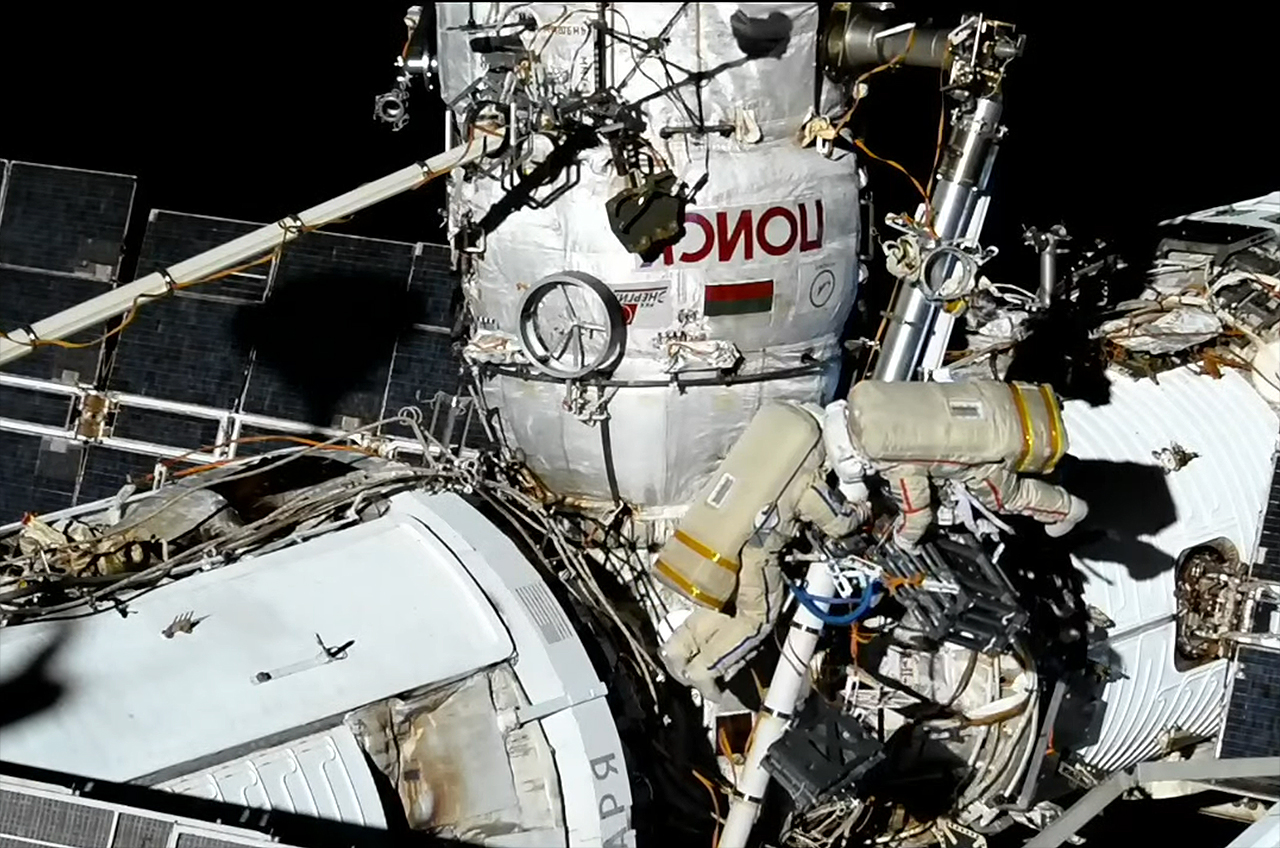Russian cosmonauts complete station spacewalk to ready radiator for move
Sergey Prokopyev and Dmitry Petelin accomplished all of their scheduled tasks during the 6.5-hour spacewalk.

Two components of the Russian side of the International Space Station are a step closer to being robotically relocated after two cosmonauts completed a spacewalk to prepare the pieces for their move.
Expedition 68 commander Sergey Prokopyev and flight engineer Dmitry Petelin, both of the Russian federal space corporation Roscosmos, conducted a six hour, 25 minute EVA (extravehicular activity) on Thursday (Nov. 17) to ready an airlock and radiator for their transfer from one Russian module to another. The hardware had been launched to the station 12 years ago aboard a NASA space shuttle and are now being repositioned to support a newer module.
Prokopyev and Petelin exited the station's space-facing Poisk module at 9:39 a.m. EST (1439 GMT) to begin the first of four planned spacewalks in support of the moves. The cosmonauts' work was primarily focused on freeing the radiator, which is used to dissipate heat and is set to be moved robotically during the next EVA scheduled for Nov. 25.
Related: The most memorable spacewalks of all time in pictures

The spacewalkers began their tasks by installing an adapter on what is called a flight-releasable grapple fixture on the airlock currently attached to Russia's Rassvet mini-research module on the Earth-facing side of the station. They next maneuvered and opened up valves in order to vent nitrogen in the hydraulic loops that have supported a radiator also housed on the exterior of Rassvet.
Completing that work in prompt fashion and without problems, Prokopyev and Petelin turned their attention to removing six radiator restraints that have been in place since the component was launched with Rassvet aboard on the space shuttle Atlantis' STS-132 mission in 2010. The two also installed a retainer on the Strela boom — an extension used by spacewalkers to move between modules — so that a foot restraint and other equipment can be mounted in support of the radiator's relocation process.
Prokopyev and Petelin's last major task of the spacewalk was to install a "large object attachment system" on the Nauka multipurpose laboratory module, where the airlock will be attached during an EVA that is scheduled for Dec. 6, two spacewalks from today's outing. During the installation, there was talk of using a hammer to knock the panel into place.
Breaking space news, the latest updates on rocket launches, skywatching events and more!
"It looks like we are not going to need the hammer," said Prokopyev.
"Yes, looks like we're lucky and the hammer won't be needed," replied Petelin.
"Well, I was all excited about hammering away in space!" Prokopyev replied.
"Well, you know, next week, next EVA, we will be removing the plug and demating the old radiator, so we are going to take all tools available with us. So you may still get the chance," said Petelin.

Expedition 68 flight engineer Anna Kikina, the only woman in Roscosmos' active cosmonaut corps, is scheduled to relocate both the airlock and radiator using the recently-added 36-foot-long (11 meters) European robotic arm from a control panel located inside the space station.
Prokopyev and Petelin reentered the space station at 4:07 p.m. EST (2107 GMT).
Thursday's EVA was the third for Prokopyev and the first for Petelin. Prokopyev has now logged 21 hours and 56 minutes on his three spacewalks.
The EVA was the 10th for the year, the second of at least seven planned for the International Space Station's current Expedition 68 mission and the 255th since 1998 in support of assembly and maintenance of the ISS.
Follow us on Twitter @Spacedotcom or on Facebook.

Robert Pearlman is a space historian, journalist and the founder and editor of collectSPACE.com, a daily news publication and community devoted to space history with a particular focus on how and where space exploration intersects with pop culture. Pearlman is also a contributing writer for Space.com and co-author of "Space Stations: The Art, Science, and Reality of Working in Space” published by Smithsonian Books in 2018.
In 2009, he was inducted into the U.S. Space Camp Hall of Fame in Huntsville, Alabama. In 2021, he was honored by the American Astronautical Society with the Ordway Award for Sustained Excellence in Spaceflight History. In 2023, the National Space Club Florida Committee recognized Pearlman with the Kolcum News and Communications Award for excellence in telling the space story along the Space Coast and throughout the world.
